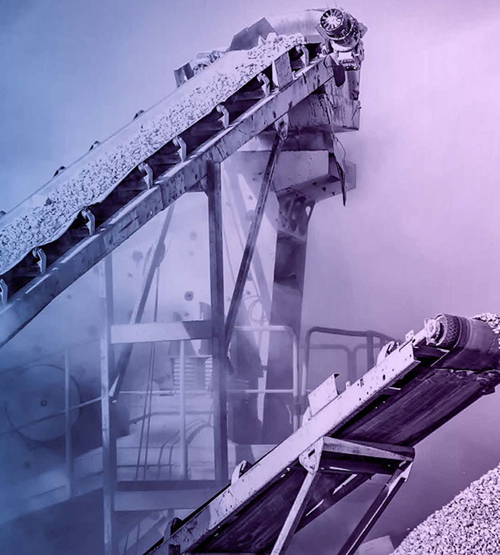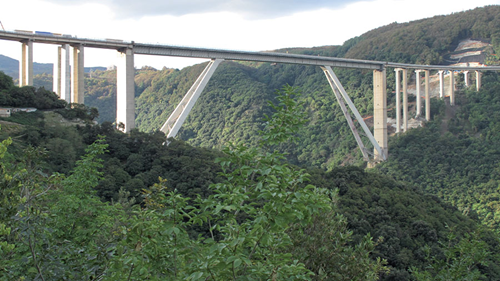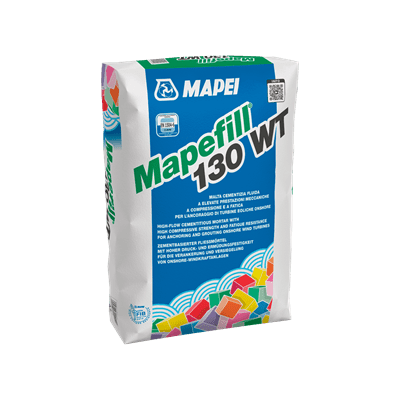

Interviews
/
6/5/2025
Gone with the wind: a new line of products for wind turbines
High performance mortars for the durability of wind turbines all around the world
Mapei enters the wind energy sector with a line of innovative products for the construction and maintenance of on-shore wind turbines. Mapegrout WT-S and WT-H mortars with high resistance to dynamic loads enhance the durability and sustainability of this type of structures. Simone Barile explains how the company supports sustainability and the energy transition with innovative and high-performance solutions.
Mapei enters the wind turbines market with a line of dedicated products for this sector. What requirements does this new line aim to fulfil?
With this new product line dedicated to the wind energy sector, Mapei’s intention is to fulfil two main requirements: on the one hand, to support the energy sector’s transition to renewable sources by offering high performance solutions, while on the other hand, to supply the wind energy sector with specific products that guarantee durability, efficiency and sustainability, even under the harshest operating conditions.
Our objective is to bring our experience to the market with systems that meet the specific requirements of the wind energy sector. The line has been developed to provide a concrete, targeted response to the real needs of professionals from this sector, of the companies and manufacturers of wind turbines.
What products make up this line?
The line that Mapei dedicates to the wind energy industry is made up of a selection of highly specialised products that are used in every phase of a wind turbine’s life cycle: from its initial build to maintenance.
To meet this demand Mapei offers a complete range of products to meet the specific needs of this market. Firstly, we have developed mortars with extremely high performance properties and high resistance to fatigue for the installation of onshore wind turbines.
These mortars are called Mapegrout WT-S and Mapegrout WT-H. Mapegrout WT-S is used for anchoring steel wind turbines and, more specifically, for filling cavities under the base plate of the wind turbine. It is part of the range of anchoring mortars for the wind energy industry and sits alongside Mapefill 130 WT, a Mapei product backed up by numerous prestigious projects and extensive experience all around the world in the successful installation of onshore wind turbines.
Mapegrout WT-H, on the other hand, has been developed to meet the needs of certain manufacturers of hybrid wind turbines. By “hybrid wind turbine”, we mean a turbine with a structure made up of pre-cast concrete ashlar blocks and tubular steel elements. Mapegrout WT-H is used to seal horizontal and vertical joints in precast concrete elements and to create the connecting joint between the metal part and the concrete part.

Mapei is committed to promoting a sustainable future, and wind energy plays a crucial role in this journey. This is why the company has developed a complete range of products for the installation of onshore wind turbines.
How did you come to developing these products?
The development of these products is the result of intense research work in collaboration with all the actors from this sector. We worked alongside contractors, technicians nd manufacturers of wind turbines, firstly to understand their needs at the start of the process, and then collecting feedback by applying materials under real operating conditions. This approach enabled us to create a reliable, safe and sustainable line that reflects the Mapei philosophy based on continuous innovation and care for the environment.
These products are part of the company’s further-reaching commitment to supplying systems that encompass the needs of the wind energy industry at 360 degrees. Today, for instance, Mapei has waterproofing systems available for the bases of wind turbines, such as products from the Purtop, Aquaflex and Mapelastic ranges. In addition, the company has an extensive portfolio of concrete admixtures that can be use to design the concrete mix for the foundations for wind turbines. And lastly, to reduce CO2 emissions during the production of concrete, as part of the target to achieve Carbon Neutrality by 2050, Mapei has developed the CUBE system: an integrated approach that helps the concrete industry overcome the difficulties arising from the use of cements with low clinker content and of aggregates of variable quality, providing support at stages (production, transport and placing). The CUBE system actively supports the industry in maintaining its high standards while reducing climate impact. Even during the formulation of concrete used for the foundations of turbines, the use of CUBE system enables the environmental impact of this material to be reduced while maintaining its mechanical strength and durability.
The objective nowadays is to build windfarms with an increasingly longer service life. To achieve this result, it is fundamental that the condition of the steel reinforcement rods in the foundations is safeguarded. And to achieve this, Mapei has its own galvanic cathodic protection systems, the Mapeshield range, to protect steel reinforcement. With respect to traditional passivating systems, it is now possible to monitor the condition of steel reinforcement over time by using Mapeshield Monitoring Box.
In addition, as already mentioned, Mapei offers its contribution to the maintenance of existing wind turines with a complete range of epoxy resins for sealing cracks in concrete bases.
What are the main characteristics of these new products?
The products from the Mapegrout WT range excel for their particularly high mechanical strength and high resistance to dynamic loads which, in turn, results in excellent resistance to fatigue. Furthermore, they are characterised by a high level of fluidity and extended workability which meet the requirements and schedules of site work. Mapegrout WT-S and Mapegrout WT-H can also be pumped over considerable distances using different types of equipment (more than 100 metres). And lastly, we should point that these products can also be applied in very thick layers: up to 600 mm.
In which markets do you expect to see most growth?
Thanks to the launch of a complete range aimed at the wind energy market, we certainly expect 360-degree growth in various geographical areas. Europe, America and Asia-Pacific are undoubtedly the regions most impacted by the installation of new wind turbines. We are already supplying our systems all around the world and we expect to consolidate our position on the international market over the next two years.
This new line is confirmation of the Group’s commitment to promoting sustainability in various sectors, in this case through the promotion of energy from non-fossil sources. And what about the products themselves?
Both Mapegrout WT-S and Mapegrout WT-H have GEV EMICODE EC1PLUS certification which certifies their low very low emission of volatile organic compounds (VOC). And soon, EPDs (Environmental Product Declaration) will also be available for Mapegrout WT-S and Mapegrout WT-H which attest, unequivocally and transparently, the environmental impact of these products.
As always, Mapei’s commitment lies in the solutions the company offers to its clients, solutions that are not only complete and sustainable, but that are also able to give structures a high level of durability. The combination of these concepts is what sets Mapei apart on the global market.
The first Mapei training event on solutions for onshore wind turbines
On 19th and 20th May, the first specialistic training course on the company's solutions for onshore wind turbines was held at Mapei SpA, organised by Mapei Academy for installation companies, manufacturers, general contractors and designers of this type of structure. As well as highlighting the properties and advantages of the use of anchoring grouts (Mapegrout WT-S and Mapegrout WT-H) specifically developed for the installation of steel and hybrid wind turbines, the course also put the spotlight on other Mapei systems and products that can be used in this specific sector from waterproofing technologies for the basements to epoxy resins for crack repair; from galvanic cathodic protection systems to prevent the corrosion of reinforcement rods and, consequently, the deterioration of concrete elements, to the integrated offer of admixtures and services of the CUBE system which allows the sustainability of concrete used to build foundations to be increased, allowing the use of cements with a low dosage of clinker and the use of recycled aggregates or secondary cementitious materials (SCM), while maintaining high (or even improving) the final performance of the mixtures. Different solutions but with a common goal: to guarantee effectiveness, strength, durability and reduced environmental impact to a type of infrastructure that will be increasingly important in the future.
An opportunity for training, exchange of skills and networking that certainly brought benefits to all the course participants and also to Mapei, which has always been attentive to the needs of professionals working in every sector of the construction industry.
_modl4213a88679c562e49128ff01007028e9.jpg?sfvrsn=b9d6ca8b_3)
On 19-20 May, the first specialistic training course on the company's solutions for onshore wind turbines was held at Mapei SpA, organised by Mapei Academy.












